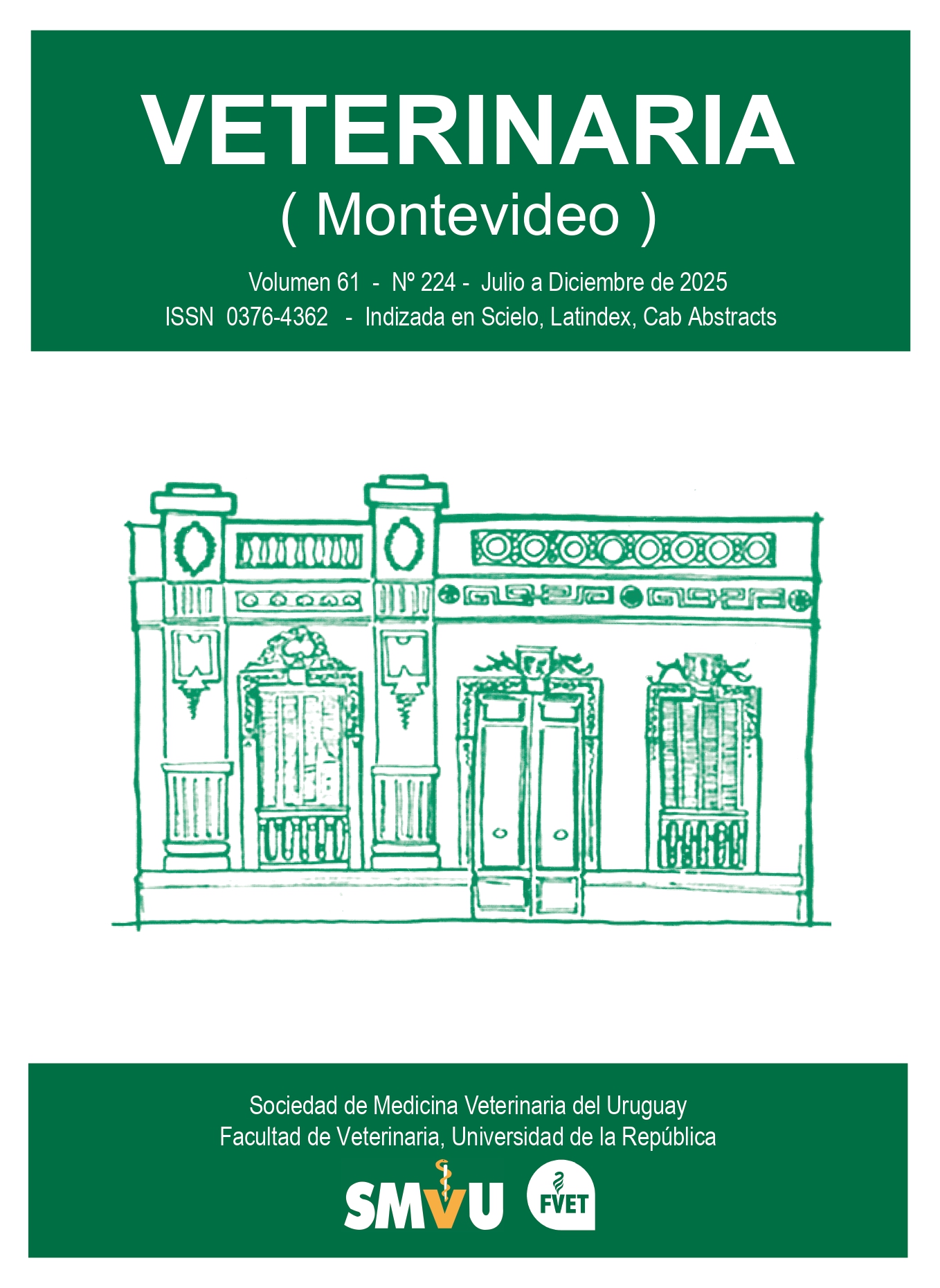What are the dogs of Barros Blancos telling us about One Health?
A prevalence study of zoonotic parasitic
DOI:
https://doi.org/10.29155/VET.61.224.4Keywords:
Public health, Zoonoses, Helminths, Social inclusionAbstract
The prevalence of helminths with zoonotic potential was analyzed in canines from Barros Blancos (34° 46' 19.384'' S, 56° 0' 15.036'' O), Canelones, Uruguay. This research arose from the detection of a case of toxocariasis (visceral larva migrans) in a child from the area, which prompted the need to investigate the presence of Toxocara canis and other zoonotic parasites in the local canine population. As part of a social inclusion project funded by CSIC-Udelar, qualitative and quantitative coprological analyses were conducted on fecal samples from dogs collected from households and public spaces. Endoparasite prevalence across all samples was 63 %. The detected parasites were: hookworms (36.5 %), Trichuris vulpis (29.5 %), T. canis (14.0 %), Eucoleus spp. (11.5 %), Cystoisospora spp. (5.5 %), Toxascaris leonina (1 %), and Dipylidium caninum (1 %). Thirty-seven percent of the samples were negative. Thirty-four and a half percent showed a single parasitic taxon, 22 % had two taxa, and 6.5 % had three or more. The highest egg count was from T. canis, with an egg per gram (epg) of 5040. Significant differences (p<0.0261) were observed in prevalence between samples collected from public spaces (69.6 %) (80/115) and those from households (54.1 %) (46/85). The results reveal a high prevalence of zoonotic helminths in the canine population of Barros Blancos, posing a public health risk. This study underscores the importance of promoting responsible pet ownership, social inclusion, and community participation in the prevention of zoonotic diseases, as well as emphasizing the need for proper feces management and environmental control.
Downloads
Metrics
References
Acuña, A., Braida, J. C., Centurión, S., Marinof, N., & Valledor, M. S. (2013). Diagnóstico socio-ambiental participativo en 3 microcuencas en la ciudad Barros Blancos, en un contexto de alta vulnerabilidad social. Anais do Congreso Brasileiro de Medicina de Familia e Comunidade, (12), 1025. https://rebecalegada.emnuvens.com.br/brasileiro/article/view/1152
Akuthota, P., & Weller, P. F. (2012). Eosinophilic pneumonias. Clinical Microbiology Reviews, 25(4), 649-660. https://doi.org/10.1128/CMR.00025-12
Bouchaud, O., Houze, S., Schiemann, R., Durand, R., Ralaimazava, P., Ruggeri, C., & Coulaud, J. P. (2000). Cutaneous larva migrans in travelers: A prospective study, with assessment of therapy with ivermectin. Clinical Infectious Diseases, 31(2), 493-498. https://doi.org/10.1086/313942
Cabrera, F., Iturralde, A., Lena, A., Saavedra, M., Cámera, M. L., García, L., González, T., Koziol, S., Acuña, A., & Giachetto, G. (2017). Enteroparasitosis en niños de dos Centros de Atención a la Infancia y la Familia (CAIF) del barrio Casavalle, Montevideo. Archivos de Pediatría del Uruguay, 88(6), 315-321. http://www.scielo.edu.uy/scielo.php?script=sci_arttext&pid=S1688-12492017000600315
Cabrera, P., Valledor, S., Castro, O., Salazar, M., & Escandell, G. (2007). Relevamiento coprológico de helmintos y protozoarios en canes rurales a nivel nacional. En Jornadas Técnicas de la Facultad de Veterinaria (Vol. 5, p. 65). Udelar.
Camacho, J. C., Infante, K. I. L., Tocasuche, M. C. T., Alcantara-Neves, N. M., & Hernández, D. A. J. (2021). Evaluación de técnicas coprodiagnósticas para Toxocara canis. Revista de Investigaciones Veterinarias del Perú, 32(3), e18861. https://doi.org/10.15381/rivep.v32i3.18861
Cristi, G. A. (1954). Capilariosis traqueal en Felis catus domesticus. Primera constatación en el Uruguay. Anales de la Facultad de Veterinaria, Uruguay, 6(1), 141-143. https://www.colibri.udelar.edu.uy/jspui/bitstream/20.500.12008/40118/1/1954%20p141-143.pdf
Da Rosa, W. D., Acuña, A. M., Giachetto, G., Durán, E., Cancel, M. J., Gutiérrez, S., & Picheli, E. (2020). Enteroparasitosis en escolares, problema de salud pública. Intervención desde el Sistema Nacional Integrado de Salud de Uruguay. Revista de Salud Pública, 22(1), 82–87. https://doi.org/10.15446/rsap.v22n1.77311
Davies, H. D., Sakuls, P., & Keystone, J. S. (1993). Creeping eruption. A review of clinical presentation and management of 60 cases presenting to a tropical disease unit. Archives of Dermatology, 129(5), 588-591. https://doi.org/10.1001/archderm.129.5.588
Deutz, A., Fuchs, K., Auer, H., Kerbl, U., Aspock, H., & Kofer, J. (2005). Toxocara-infestations in Austria: A study on the risk of infection of farmers, slaughterhouse staff, hunters and veterinarians. Parasitology Research, 97(5), 390-394. https://doi.org/10.1007/s00436-005-1469-5
Drake, L. J., Jukes, M. C. H., Sternberg, R. J., & Bundy, D. A. P. (2000). Geohelminth infections (ascariasis, trichuriasis, and hookworm): Cognitive and developmental impacts. Seminars in Pediatric Infectious Diseases, 11(4), 245-251.
Dunn, J. J., Columbus, S. T., Aldeen, W. E., Davis, M., & Carroll, K. C. (2002). Trichuris vulpis recovered from a patient with chronic diarrhea and five dogs. Journal of Clinical Microbiology, 40(7), 2703-2704. https://doi.org/10.1128/jcm.40.7.2703-2704.2002
Eckert, J., Gemmell, M.A., Meslin, F. X., & Pawlowski, Z.S. (2001). WHO/OIE Manual of Echinococcosis in Humans and Animals: A Public Health Problem of Global Concern. Organization for Animal Health and World Health Organization.
Erickson, L. D., Gale, S. D., Berrett, A., Brown, B. L., & Hedges, D. W. (2015). Association between toxocariasis and cognitive function in young to middle-aged adults. Folia Parasitologica, 62. https://doi.org/10.14411/fp.2015.048
Etewa, S. E., Abdel-Rahman, S. A., Abd El-Aal, N. F., Fathy, G. M., El-Shafey, M. A., & Ewis, A. M. (2016). Geohelminths distribution as affected by soil properties, physicochemical factors and climate in Sharkyia governorate Egypt. Journal of Parasitic Diseases, 40(2), 496–504. https://doi.org/10.1007/s12639-014-0532-5
European Scientific Counsel Companion Animal Parasites. (2022). Parasitological diagnosis in cats, dogs and equines (4.ª ed.). https://www.esccap.org/uploads/docs/ebjqliec_1335_ESCCAP_GL4__English_v4_1p.pdf
Ferraz, S., & Ferreira, L. (2008). Estudio de la presencia de géneros de nematodes zoonóticos en los perros que pertenecen a los niños preescolares de la Escuela N.o 225 [Tesis de grado, Facultad de Veterinaria, Universidad de la República]. Colibrí. https://www.colibri.udelar.edu.uy/jspui/bitstream/20.500.12008/19217/1/FV-28187.pdf
Fontanarrosa, M. F., Vezzani, D., Basabe, J., & Eiras, D. F. (2005). An epidemiological study of gastrointestinal parasites of dogs from Southern Greater Buenos Aires (Argentina): Age, gender, breed, mixed infections, and seasonal and spatial patterns. Veterinary Parasitology, 136(3-4), 283-295. https://doi.org/10.1016/j.vetpar.2005.11.012
Gallo, I. (2021). Determinación de la situación sanitaria de los diferentes helmintos zoonóticos transmitidos por caninos en la ciudad de Florida [Tesis de grado, Facultad de Veterinaria, Universidad de la República]. Colibrí. https://www.colibri.udelar.edu.uy/jspui/bitstream/20.500.12008/33848/1/FV-34458.pdf
Hall, J. E., & Sonnenberg, B. (1956). An apparent case of human infection with the whipworm of dogs, Trichuris vulpis (Froelich, 1789). Journal of Parasitology, 42(2), 197-199. https://doi.org/10.2307/3274735
Hochedez, P., & Caumes, E. (2007). Hookworm-related cutaneous larva migrans. Journal of Travel Medicine, 14(5), 326-333. https://doi.org/10.1111/j.1708-8305.2007.00148.x
Intirach, J., Shu, C., Lv, X., Gao, S., Sutthanont, N., Chen, T., & Lv, Z. (2024). Human parasitic infections of the class Adenophorea: Global epidemiology, pathogenesis, prevention and control. Infectious Diseases of Poverty, 13(1), 48. https://doi.org/10.1186/s40249-024-01216-1
Kagei, N., Hayashi, S., & Kato, K. (1986). Human cases of infection with canine whipworms, Trichuris vulpis (Froelich, 1789), in Japan. Japanese Journal of Medical Science and Biology, 39, 177-184. https://doi.org/10.7883/yoken1952.39.177
Kenney, M., & Yermakov, V. (1980). Infection of man with Trichuris vulpis, the whipworm of dogs. American Journal of Tropical Medicine and Hygiene, 29(6), 1205-1208. https://doi.org/10.4269/ajtmh.1980.29.1205
Little, S. E., Johnson, E. M., Lewis, D., Jaklitsch, R. P., Payton, M. E., Blagburn, B. L., Bowman, D. D., Moroff, S., Tams, T., Rich, L., & Aucoin, D. (2009). Prevalence of intestinal parasites in pet dogs in the United States. Veterinary Parasitology, 166(1-2), 144-152. https://doi.org/10.1016/j.vetpar.2009.07.044
Masuda, Y., Kishimoto, T., Ito, H., & Tsuji, M. (1987). Visceral larva migrans caused by Trichuris vulpis presenting as a pulmonary mass. Thorax, 42(12), 990-991. https://doi.org/10.1136/thx.42.12.990
Mena, L. A. E., Duarte-Ubaldo, E., Vargaz-Magaña, J., García-Ramírez, M., & Medina-Hernández, R. (2011). Prevalencia de parásitos gastroentéricos de cánidos en la ciudad de Escárcega, Campeche, México. Universidad y Ciencia, 27(2), 209-217, https://dialnet.unirioja.es/servlet/articulo?codigo=5318676
Morelli, S., Di Cesare, A., Traversa, D., Colombo, M., Paoletti, B., Ghietti, A., Beall, M., Davenport, K., Buch, J., Iorio, R., Marchiori, E., Di Regalbono, A. F., & Diakou, A. (2024). Comparison of diagnostic methods for laboratory diagnosis of the zoonotic tapeworm Dipylidium caninum in cats. Veterinary Parasitology, 331, 110274. https://doi.org/10.1016/j.vetpar.2024.110274
Muhleisen, J. P. (1953). Demonstration of pulmonary migration of the causative organism of creeping eruption. Annals of Internal Medicine, 38(3), 595-600. https://doi.org/10.7326/0003-4819-38-3-595
Portokalidou, S., Gkentzi, D., Stamouli, V., Varvarigou, A., Marangos, M., Spiliopoulou, I., & Dimitriou, G. (2018). Dipylidium caninum infection in children: Clinical presentation and therapeutic challenges. The Pediatric Infectious Disease Journal, 38(7), e157-e159. https://doi.org/10.1097/inf.0000000000002235
Programa Integral Metropolitano. (2013). Caracterización del territorio Barros Blancos. https://pim.udelar.edu.uy/wp-content/uploads/sites/14/2013/04/Caracterizaci%C3%B3n-del-territorio-Barros-Blancos.pdf
Reiczigel, J., Abonyi-Tóth, Z., & Singer, J. (2008). An exact confidence set for two binomial proportions and exact unconditional confidence intervals for the difference and ratio of proportions. Computational Statistics & Data Analysis, 52(11), 5046-5053. https://doi.org/10.1016/j.csda.2008.04.032
Reiczigel, J., Marozzi, M., Fábián, I., & Rózsa, L. (2019). Biostatistics for parasitologists - A primer to quantitative parasitology. Trends in Parasitology, 35(4), 277-281. https://doi.org/10.1016/j.pt.2019.01.003
Roddie, G., Stafford, P., Holland, C., & Wolfe, A. (2008). Contamination of dog hair with eggs of Toxocara canis. Veterinary Parasitology, 152(1-2), 85-93. https://doi.org/10.1016/j.vetpar.2007.12.008
Rojas, A., Germitsch, N., Oren, S., Sazmand, A., & Deak, G. (2024). Wildlife parasitology: Sample collection and processing, diagnostic constraints, and methodological challenges in terrestrial carnivores. Parasites & Vectors, 17(1). https://doi.org/10.1186/s13071-024-06226-4
Sakano, T., Hamamoto, K., Kobayashi, Y., Sakata, Y., Tsuji, M., & Usui, T. (1980). Visceral larva migrans caused by Trichuris vulpis. Archives of Disease in Childhood, 55(8), 631-633. https://doi.org/10.1136/adc.55.8.631
Salcedo‐Jiménez, J., Alcala‐Canto, Y., Segura‐Tinoco, J., Valadez‐Moctezuma, E., & Pérez‐Rivero, J. J. (2024). Identifying zoonotic parasites in domiciled and non‐domiciled dogs (Canis lupus familiaris) within an urban zone of the Eastern State of Mexico. Veterinary Medicine and Science, 10(6), e70059. https://doi.org/10.1002/vms3.70059
Samorek-Pieróg, M., Cencek, T., Łabuć, E., Pac-Sosińska, M., Pieróg, M., Korpysa-Dzirba, W., Bełcik, A., Bilska-Zając, E., & Karamon, J. (2023). Occurrence of Eucoleus aerophilus in wild and domestic animals: A systematic review and meta-analysis. Parasites & Vectors, 16(1), 245. https://doi.org/10.1186/s13071-023-05830-0
Schurer, J., Davenport, L., Wagner, B., & Jenkins, E. (2014). Effects of sub-zero storage temperatures on endoparasites in canine and equine feces. Veterinary Parasitology, 204(3-4), 310-315. https://doi.org/10.1016/j.vetpar.2014.05.008
Soriano, S. V., Pierangeli, N. B., Roccia, I., Bergagna, H. F. J., Lazzarini, L. E., Celescinco, A., Saiz, M. S., Kossman, A., Contreras, P. A., Arias, C., & Basualdo, J. A. (2009). A wide diversity of zoonotic intestinal parasites infects urban and rural dogs in Neuquén, Patagonia, Argentina. Veterinary Parasitology, 167(1), 81-85. https://doi.org/10.1016/j.vetpar.2009.09.048
Strube, C., & Mehlhorn, H. (Eds.). (2022). Dog parasites endangering human health (Vol. 13). Springer. https://doi.org/10.1007/978-3-030-53230-7
Sykes, J. E. (2023). Greene’s infectious diseases of the dog and cat (5th ed.). Elsevier Health Sciences.
Tavassoli, M., Javadi, S., Firozi, R., Rezaei, F., Khezri, A. R., & Hadian, M. (2012). Hair contamination of sheepdog and pet dogs with Toxocara canis eggs. Iranian Journal of Parasitology, 7(4), 110.
Traversa, D. (2011). Are we paying too much attention to cardio-pulmonar nematodes and neglecting old-fashioned worms like Trichuris vulpis? Parasites & Vectors, 4(1), 32. https://doi.org/10.1186/1756-3305-4-32
Traversa, D., Di Cesare, A., & Conboy, G. (2010). Canine and feline cardiopulmonary parasitic nematodes in Europe: Emerging and underestimated. Parasites & Vectors, 3(1), 62. https://doi.org/10.1186/1756-3305-3-62
Valledor, M. S., Castro, O., Décia, L., Eguren, J., Pérez, V., Harán, G., & Cabrera, P. A. (2006). Relevamiento de helmintos intestinales en perros urbanos de Montevideo y Florida y perros rurales del departamento de Florida, con el registro de un nuevo género de nematodo parasitando al canino en nuestro país. Veterinaria (Montevideo), 41(163-164), 43-49. https://revistasmvu.com.uy/index.php/smvu/article/view/295/183
Willis, H. H. (1921). A simple levitation method for the detection of hookworm ova. The Medical Journal of Australia, 2(18), 375-376. https://doi.org/10.5694/j.1326-5377.1921.tb60654.x
Witkind, J., Durán, E., & Bonifacino, R. (1983). Determinación de anticuerpos anti-Toxocara canis por la técnica de doble difusión en agar (Ouchterlony). Revista Uruguaya de Patología Clínica, 19-20, 17-26.
Zajac, A. M., Conboy, G. A., Little, S. E., & Reichard, M. V. (2021). Veterinary clinical parasitology (9.ª ed.). John Wiley & Sons.
Zanetta, E., & Basmadjián, Y. (2002). Zoonosis parasitarias en la salud pública en Uruguay. En Jornadas de Parasitología Veterinaria (pp. 28-32). Departamento de Parasitología, Facultad de Veterinaria.
Published
How to Cite
Issue
Section
License
Copyright (c) 2025 Sociedad de Medicina Veterinaria del Uruguay-Facultad de Veterinaria, Universidad de la República

This work is licensed under a Creative Commons Attribution 4.0 International License.











